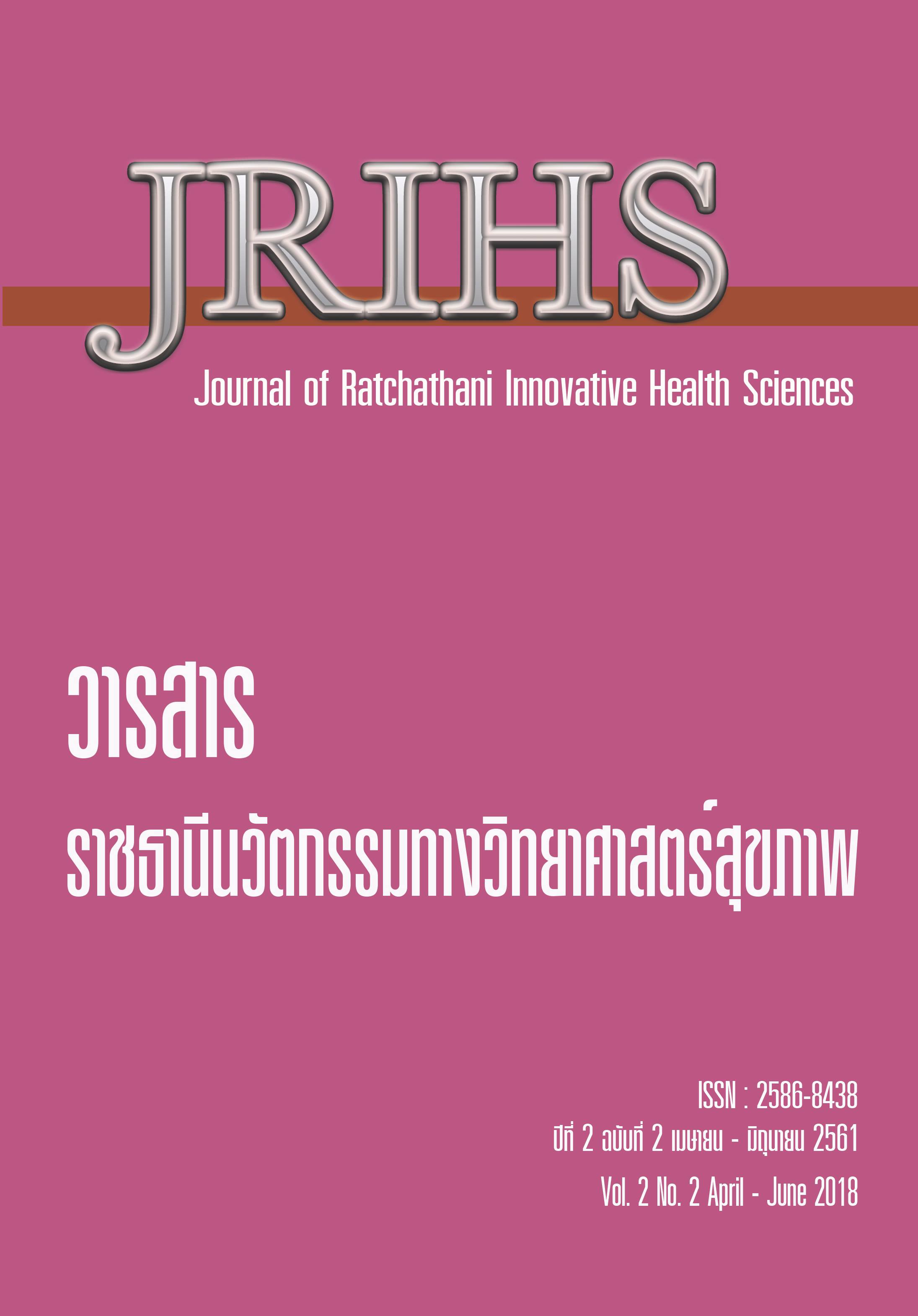Self-awareness and Recognition benefits of Self-awareness of nursing student in a private university in Ubon Ratchathani Province
Main Article Content
Abstract
Descriptive research aims to compare self-awareness, Perceived benefits of self-awareness of nursing students. And study the application of self-awareness to the use of nursing students in a Private University Ubon Ratchathani province. Sample is a graduate student private university in Ubon Ratchathani province, 190 people. This research consisted of questionnaires, including self-awareness questionnaires. Self-awareness benefit questionnaire and the questionnaire on self-awareness for use in daily life. Statistics used in data analysis were mean, percentage, standard deviation. Comparison of differences with analytical statistics One way ANOVA.
The research found that comparison of self-awareness of the sample group different with statistical significance at .05 level (P = .001). With the third year having the most self-awareness followed by second year and first year respectively. And comparison of perceived benefits, self-awareness of the sample group different with statistical significance at .05 level (P = .012). With the third year having the most self-awareness Followed by second year and first year respectively. And samples with the awareness of using in daily life by using it to understand your emotions enabling self-control as well as knowing weaknesses. To be used to develop self-improvement in a rational lifestyle. For applying self-awareness to work practices, it was found that the sample group will be used to remind yourself to know yourself make you conscious and careful while working or practice work.
Article Details
ความคิดเห็นและข้อเสนอแนะใดๆ ที่นำเสนอในบทความเป็นของผู้เขียนแต่เพียงผู้เดียว โดยบรรณาธิการ กองบรรณาธิการ และคณะกรรมการวารสารราชธานีนวัตกรรมทางวิทยาศาสตร์สุขภาพไม่ได้มีส่วนเกี่ยวข้องแต่อย่างใด มหาวิทยาลัยราชธานี บรรณาธิการ และกองบรรณาธิการจะไม่รับผิดชอบต่อข้อผิดพลาดหรือผลที่เกิดขึ้น จากการใช้ข้อมูลที่ปรากฏในวารสารฉบับนี้
References
ฉวีวรรณ สัตธรรม. (2557). การพยาบาลจิตเวชและสุขภาพจิต (พิมพ์ครั้งที่ 2). กรุงเทพฯ: สถาบันพระบรมราชชนก กระทรวงสาธารณสุข.
ทัศนีย์ สุริยะไชย. (2554). ความสัมพันธ์ระหว่างการตระหนักรู้ในตนเองกับการร่วมรู้สึกในวัยรุ่น.
(การศึกษามหาบัณฑิต สาขาจิตวิทยาพัฒนาการ บัณฑิตวิทยาลัย มหาวิทยาลัยศรีนครินทรวิโรฒ).
ธณัชช์นรี สโรบล. (2560). การพัฒนาทักษะการคิดอย่างมีวิจารณญาณโดยการใช้การสะท้อนคิด. วารสารวิทยาลัยบรมราชชนนี เชียงใหม่, 46(1), 89-90.
เพชรรุ่ง เพชรประดับ. (2558). ปัจจัยที่มีผลต่อพฤติกรรมการจัดการภาวะขาดแคลนพยาบาล. ผลงานวิจัยระดับบัณฑิตศึกษา. ใน. การจัดประชุมเสนอผลงานวิจัยระดับบัณฑิตศึกษามหาวิทยาลัยสุโขทัยธรรมาธิราช ครั้งที่ 4 The 4th STOU Graduate Research Conference วันที่ 26-27 พฤศจิกายน 2558.
เรวัต เงินเย็น. (2558). ปัจจัยเชิงสาเหตุที่ส่งผลต่อความตระหนักรู้ในตนเองของนักเรียนระดับชั้น
มัธยมศึกษาตอนปลาย โรงเรียนสังกัดองค์กรปกครองส่วนท้องถิ่น จังหวัดเชียงราย. วารสารบัณฑิตศึกษา มหาวิทยาลัยราชภัฏเชียงราย, 8(18) กันยายน-ธันวาคม, 183-188.
วราพร วันไชยธนวงค์, วราภรณ์ ยศทวี, และจุฬาวรี ชัยวงค์นาคพันธ. (2560). การพัฒนาความตระหนักในคุณค่าของชีวิตสำหรับนักศึกษาพยาบาล. วารสารวิทยาลัยพยาบาลบรมราชชนนี อุตรดิตถ์. 9(2) กรกฎาคม–ธันวาคม, 112-127.
สายฝน เอกวรางกูร. (2562). การพยาบาลจิตเวชและสุขภาพจิตศาสตร์และศิลป์ สู่การปฏิบัติ 1.กรุงเทพฯ: ไทม์ พริ้นติ้ง.
สายสมร เฉลยกิตติ. (2557). วิถีทางสร้างสุขสำหรับนักเรียนพยาบาล. พยาบาลทหารบก.
15( 2), 92-98
สุภิชญา ทองแก้ว. (2561). ความตระหนักต่อความปลอดภัยผู้ป่วยของพยาบาลวิชาชีพใหม่ใน โรงพยาบาลทั่วไป. เครือข่ายวิทยาลัยพยาบาลและการสาธารณสุขภาคใต้, 5(1), 64-65.
Krejcie, R.V. & Morgan, D.W. (1970). Determining Sample Size for Research Activities.
Educational and Psychological Measurement, 30(3), 607-610.


